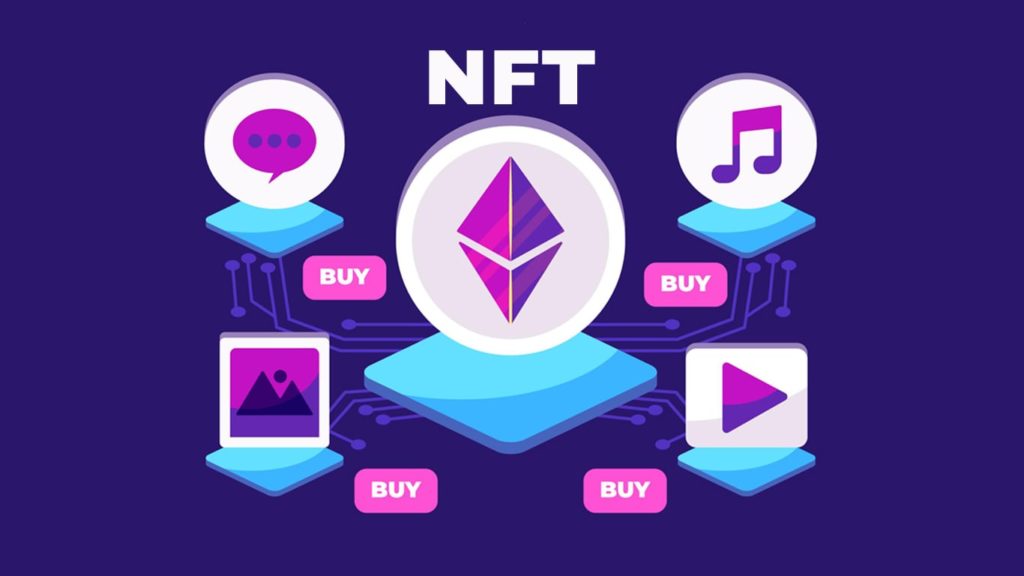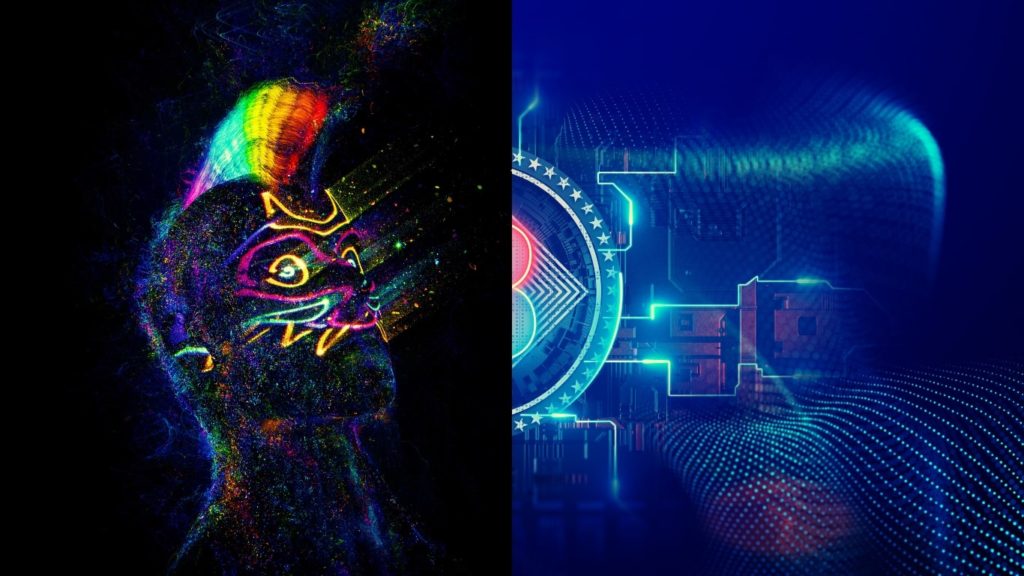
Cryptocurrencies and blockchain technology continue to capture headlines as they gain a larger foothold in mainstream culture. One of the most common forms of cryptocurrency is NTF (Non-Fungible Token), which can vary widely by design and purpose. These ‘digital assets’ act similarly to items, goods, or services we all currently use daily, but they carry their unique characteristics.
NFT Definition
A Non-Fungible Token (NFT) is a piece of data stored on a ‘ledger’, also referred to as a ‘blockchain,’ that verifies a digital asset.

Non-fungible tokens are unique digital assets, i.e., only one iteration exists, a fact provable by the blockchain. They can be used to represent both tangible and intangible items. Their value is intrinsically linked to their design. An NFT ecosystem comprises different exchanges, ICO (Initial Coin Offering), browsers, wallets, payment systems, marketplaces, and other relevant companies and projects.
NFTs don’t need to be limited to digital assets, however. A common example of an NFT is a virtual item in a game. These tokens don’t share the same ownership rules as regular cryptocurrencies, such as Bitcoin.
The most well-known NFTs at the time of writing are “CryptoKitties,” “ERC-721 Non-Fungible Tokens,” and “Rare Pepe.”
In short, non-fungible tokens improve the digital asset ecosystem. NFTs allow for descriptions of digital assets in a more accurate, scalable, and interoperable way over traditional methods.
What’s the Difference Between NFTs and Cryptocurrency?

Three main features make NFTs different from traditional cryptocurrencies. However, the main is ownership. Cryptocurrencies can’t be owned, at least not as you know it from traditional assets. There’s no room for the kind of ownership you might recognize from traditional financial instruments in a cryptocurrency transaction.
When you exchange cryptos, you’re essentially swapping your claim on some set of assets for a claim on another set of assets. This way, the concept of ownership is divorced from the traditional legal ownership model. Therefore, you can identify transactions as being made with a particular coin or token by looking at how those tokens are used in smart contracts.
The following table explores the differences between NFTs and cryptocurrencies:
| Feature | NFTs | Cryptocurrencies |
|---|---|---|
| Nature | Digital assets that serve as proof of ownership or authenticity | Digital currency that can facilitate economic transactions |
| Fungibility | Non-fungible as each token is unique and irreplaceable | Fungible, as two tokens have the same value and are thus interchangeable |
| Blockchain | Can use various blockchains | Can only use specific blockchains |
| Purpose | To represent ownership | As a medium of exchange |
| Value | Subjective value based on the actual product | Value follows market sentiment |
| Use Cases | Mostly used to buy art, gaming assets, and digital products | Mostly used as investments and for financial transactions |
| Examples | CryptoPunks | Bitcoin |
Why are NFTs Popular?
NFTs are popular because of:
- The fact that they’re linked to real-world assets
- The increased popularity of the blockchain in recent years
NFTs can be useful, especially in collectibles and brands where consumers desire unique items. However, they can also be dangerous, especially to consumers who aren’t well-versed in the technology.
Concerns have been raised about NFTs and some of their pitfalls, such as the high transfer fees charged by many crypto exchanges. This has brought them into the limelight recently. However, we don’t yet know the future of NFTs or how this technology will evolve.
Non-Fungible Token Applications
Reminder: non-fungible tokens (NFTs) are digital assets that maintain specific ownership and cannot be replicated or cloned. This characteristic makes them useful in the world of collectibles, where they are referred to as collectible items or “Cells”.
1. CryptoTycoon
In the realm of CryptoTycoon (CTT), various blockchain projects have focused on solving problems specific to this asset class. The founders of CTT were tied to Tencent Interactive Entertainment (IEG). You can earn these NFTs in games like Monopoly Tycoon and FishSwap.
2. FirstBlood
FirstBlood is a sports-focused token sale platform that allows players to connect with sponsors and merchandise through their smart contracts. Players can access a smart contract to purchase, sell or trade digital assets.
The platform is creating a marketplace for tokenized equity in sports and video games through NFTs. The company has released its tokens (BMR). It’s also in the process of issuing its ERC-20 utility token, which will be used to incentivize spending on the platform.
The team is also building its protocol to create a decentralized ecosystem for tokenized equity. Fans can buy in and support their favorite players, allowing the tokens to be used to access premium content on the platform. In addition to its management team, FirstBlood has secured some notable advisors for the project.
FirstBlood is also in the process of working with both the International eSport Federation (IeSF) and the U. S. Olympic Committee (USOC) to ensure compliance with applicable regulations. This NFT is also working with EIP on the creation of a tokenized version of the developer platform, EIP1101.
Examples of NFTs
Some latest examples include Cryptokitties, CryptoBots, CryptoPunks, and Utrum tokens. Non-fungible tokens are immutable, unique, and transferable assets that cannot be broken down into smaller units. For example, gold or a gold coin cannot be divided into smaller pieces without losing its value and purchasing power.
In contrast, a penny can be divided into smaller pieces without losing its value and purchasing power. Non-fungible tokens exist on the blockchain but are created and managed by a smart contract instead of controlled by a central authority. The following are some examples of NFTs you can relate to:
- Buying and selling domain names
- Buying in-game items
- Digital artwork (images, videos, graphics, and more)
- Retail auction in a limited-run fashion line
- Things similar to digital collectibles
- Ticket to access an event or a coupon
NFT Use Cases
Despite being the new kid on the block, NFTs do have a few use cases, which are as follows:
1. For buying digital collectibles
NFTs can be used to buy digital collectibles online. These collectibles can be anything from graphic art to a soundtrack or a gaming asset. By using NFTs, these collectibles are tokenized, which is basically creating a unique token for the collectible using blockchain technology.
2. Purchasing Fine Art
Yes, other than collectibles, people are also using them to buy ownership in fine art. They tokenize the art by creating NFTs exclusive to it and then selling the NFT, which signifies ownership. It entails using a blockchain technology called smart contracts, which basically contain enough information regarding the art that can be used to authenticate its origins, provenance, creator, and current owner.
3. To Buy a House
NFTs are also making headway in the real estate market, as they can be used to establish homeownership. The person selling the property can create an NFT based on the value of the house and then use the blockchain to transfer the NFT to the buyer. It is considered a much more transparent, secure, and efficient method of transaction, especially when it comes to real estate.
4. Event Ticketing
Similarly, NFTs are also created for tokenized tickets to any events, shows, live productions, concerts, and so on. The tickets are flushed on a blockchain as an NFT and then bought and sold there. It can help both the artists and buyers as it removes the middleman from the transaction, thus lowering the price of said tickets. And since these NFTs are transparent, there is no chance of any fraudulent activities.
5. Supply Chain Management
Lastly, we have supply chain management, which has also benefited from the use of NFTs. Blockchain is touted by many to be the future of global and international trade, and NFTs are at the core of this concept. Any shipment can be easily tracked, authenticated, and logged securely if it is tokenized.
Future of NFTs and FTs
Tokenized equity, debt, and other real-world assets represent an opportunity for crypto assets to bridge the digital divide. They also provide financial inclusion to under-banked and under-served communities, offer cheaper alternative financial services to unbanked individuals, and support the growth of new financial ecosystems.
But, the tokenization of these assets poses different challenges than the tokenization of traditional cryptocurrencies.
While NFTs are not yet regulated, some in the community believe there is a need for a “Stablecoin” that serves as a go-to asset for tokenized real-world assets on the EOS platform. Some think this may lead to the development of a new Stablecoin tied to USD or another base asset.
However, USDT (Tether) is not the only Stablecoin pursued by several token communities. Stablecoins like Maker’s Dai and Switzerland-based eco-financing startup BankToTheFuture’s BFToken are similar. There’s also the token created by Synthium’s partnership with Gibraltar Stock Exchange.
These make the community think multiple Stablecoins could co-exist. All Stablecoins are technically based on a single asset, e.g., USDT is backed by the US dollar. However, each stablecoin is targeted to different use cases.